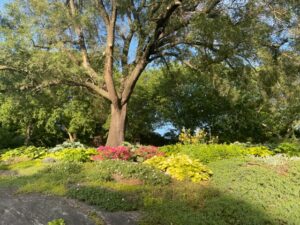When spring arrives, I always feel a bit excited and nervous. After the slow pace of winter, spring brings a sense of urgency to make the changes in my life that I’ve been contemplating but putting off. I see the beauty of the trees with their fresh green leaves, the flowers bursting into bloom, and the creativity of nature, and I know that this creativity, always renewing, is in me as well.
I am again reminded that we humans are not separate from nature. We are a part of the web of life. Ancient philosophies and spiritual traditions hold that, like the world around us, our bodies consist of the elements of water, earth, air, fire, and a fifth element, ether or space. These five elements are the constituents of all existence and help us understand the nature of reality.
I’m also reminded of the ongoing climate crisis and the realization that we are affected by it not only physically but also mentally and emotionally.
We’ve just celebrated the 55th anniversary of the first Earth Day, which took place on April 22nd, 1970. On that day, twenty million people, one in ten Americans, marched to express our concern for the earth, which was experiencing more frequent disasters caused by climate change and pollution. These powerful and peaceful actions led to the creation of the Environmental Protection Agency, the Clean Air Act, and the Clean Water Act.
Indigenous traditions, such as the Native Americans, have a sacred relationship with Mother Earth. They feel that rather than owning nature, we belong to nature and have a responsibility to care for her. They also know that our health is interconnected with the health of the planet. They are mindful that the health of the earth ensures the health of the living beings who live on the earth.
Mindfulness means paying attention to the present moment and making mindful choices based on our values, choices that will benefit all of us.
Mindfulness helps us become less anxious, enables us to focus better, and makes us more resilient. Spending time in nature can have the same effects. Nature is the great healer. Combining mindfulness and being in nature, we develop a strong understanding of our interconnectedness, a sense of grounding, and a firmer appreciation for the life we have been given.
Our natural habitat is in nature. However, we often face obstacles to spending time outside. We might live in cities, as I do, or work long hours. But we can still connect with nature regularly for short periods.
1. Look out the window. Gaze at the trees or the sky every half hour or so.
2. Get outside for 15 or 20 minutes. Walk around the block or to a nearby park.
3. Bring plants into your home or workspace. I often take breaks just to look at my plants and appreciate them. They feel my energy, too.
4. Have a photo on your desk of a favorite outdoor place. I have a picture of a beautiful beach with clear blue water.
Consider the research:
- Exposure to nature is associated with mental health and cognitive benefits.
- Individuals can consciously add brief mindfulness practices to enhance their connection to nature.
- Building these habits may also lead people to longer immersion in nature, which can deepen the benefits.
By practicing mindfulness and spending time in nature, we will gain the persistence and courage to work for the benefit of the planet and all sentient beings. Caring for the earth is self-care, too.
“Look deep into nature, and then you will understand everything better.” – Albert Einstein

